Protected Areas and Outdoor Sports. Best Friends Forever?
At the 6th Outdoor Sports Euro’Meet 2022, EUROPARC organised the workshop “Protected Areas and Outdoor Sports. Best Friends Forever?”. The event took place in #Silkeborg, the Outdoor Capital of Denmark, between the 14-16 of September 2022.
Background of the event
Outdoor Sports are an excellent way to connect people to nature. However, conflicts arise when sports are practised unsustainably, or when different users have conflicting interests. EUROPARC has signed a memorandum of understanding with ENOS, the European Network of Outdoor Sports, to tackle these challenges together. As such, we were invited to take part in the 6th Euro-Meet earlier this year.
The event followed the theme “Green Sports for a Greener and Healthier Europe“. EUROPARC’s Teresa Pastor presented at a poster session and also led a workshop at the event.
The workshop – Sharing expectations and triggering ideas
To set the scene, Teresa presented the results of a survey, which was conducted in the framework of the SEE project. The topic was the perceptions that Protected Areas managers have about Outdoor Sports practitioners.
The feedback revealed that 45% of the respondents were positive about Outdoor Sports for the benefits they bring. Nonetheless, 17% had a less-positive perception, due to the negative socio-environmental impacts Outdoor Sports can exert, while 48% positioned themselves as neutral.
With outdoor sports practitioners’ numbers steadily increasing, a risk of a shift from neutral to a negative perception is arising.
The workshop was a perfect venue to discuss different ideas in favour of a constructive dialogue to better accommodate Outdoor Sports in Protected Areas.
The first question we asked ourselves was: who should we hold responsible for the dialogue between Protected Areas and Outdoor Sports?
The general opinion was that the responsibility should be equally shared between Protected Area managers and Outdoor Sports organisations. Still, the process should be triggered by the Protected Area manager, as they are responsible for managing the natural space. Third parties that play a role are individual practitioners, however, they are more difficult to approach. Still, it is important to underline that each Outdoor Sports practitioner holds the responsibility for their own actions.
The workshop also gave the opportunity for those engaged in Outdoor Sports, to express what they expect from Protected Areas:
- To receive more and better information about:
The impacts Outdoor Sports create on the Protected Area;
Management decisions;
Where they are allowed to go, i.e. better MapTrails; - To offer better designed, more suitable facilities. Especially for Outdoor Sports practitioners to be able to co-participate in their design to ensure they are fit for the purpose. Recreational infrastructure and facilities are key management tools;
- A better understanding of each Outdoor Sports specific features;
- To be open for dialogue, including different user groups;
- To be open to partnerships.
In turn, Protected Areas expressed what they expect from Outdoor Sports:
- Respect for rules;
- Respect for the environment and the site;
- Willingness to participate in open dialogue;
- More pro-activeness in proposing actions and participating in co-design.
Our steps for dialogue
Finally, three basic steps to starting dialogue were agreed:
- Awake the interest;
- Raise awareness about the main impacts and issues associated with Outdoor Sports;
- Improve knowledge about impacts through consultation with different Outdoor Sports groups in order to make knowledge-based decisions.
The group concluded that there is a genuine interest from both sectors to mutually understand each other and to start dialogue and cooperation in order to stay best friends forever!
Want to know more?
If you are interested in further outcomes of the events, as well as other presentations, you can find them all on the ENOS’ website here.
We also launched a second call for feedback on the topic: Sustainability and Environmental Education in Outdoor Sports: Survey on Outdoor Sports in Protected Areas, and are keen to get your views! The questionnaire takes approximately 15 minutes to fill in and is available in four languages (English, French, German, Spanish).
EUROPARC Webinar, 1.12: Spotlight on Youth
We invite you to the next EUROPARC webinar “Spotlight on Youth – Creating opportunities for young people in and around Protected Areas”.
- 1.12.
- 15:00 – 16:00 CET
- Free, but registration is mandatory
The webinar
Young people are the future of Protected Areas in Europe.
As such, EUROPARC believes our Parks and Protected Areas should make sure that young people have a role in shaping and building this future, today. After all, youngsters can make a great contribution to their local community when encouraged to participate in nature orientated events – and Protected Areas are well-placed to give them this opportunity.
The EUROPARC Youth Manifesto, launched in 2018, paved a way with clear visions of a future built together with youth, Protected Areas and local municipalities. Since then, there have been many initiatives to implement these visions on local levels.
In this webinar we want to showcase three examples where Protected Areas have implemented various projects to increase opportunities for young people to take up active roles in their Protected Areas and local communities. Get inspired, and see how your Protected Area can support and empower youth, to create the green future of tomorrow!
The Programme
Welcome and Introduction
Jessica Micklem-Kolenić, EUROPARC Federation
The Cairngorms Youth Action Team
Iona Kellas, Cairngorms National Park, Scotland
The International Youth+ Volunteer Summer Experience
Johanna Ugander, Kullaberg Nature Reserve, Sweden
The Up Skill Down Dale Programme
Caroline Hall, Yorkshire Dales National Park, England
Q&A
Discussion with Participants
The Speakers

Iona Kellas
Cairngorms Youth Action Team member, Cairngorms National Park, Scotland
Iona has been active in the Cairngorms National Park as a Junior Ranger since she was 12 years old. Her passion for nature and the Protected Area led her to continue her engagement as a member of the Cairngorms Youth Action Team for the last 3 years.
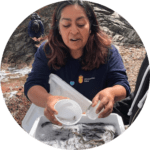
Johanna Ugander
Nature Guide at Kullaberg Nature Reserve, Sweden
Johanna loved the experience of working with a mixture of different ages, cultures and countries which took place at this year’s pilot Youth+ volunteering in Sweden. She is looking forward to having more opportunities to work with international Youth+ in the future. As a nature guide, Johanna works on getting people as excited about nature as she is.

Caroline Hall
Youth Volunteer Officer at the Yorkshire Dales National Park Authority, England
Caroline is passionate about working with young people, especially groups who face barriers to accessing nature. She is also an experienced mental health practitioner and forest school practitioner and feels very lucky to be able to work outside with brilliant groups of young people!

Jessica Micklem-Kolenić
Youth Officer at the EUROPARC Federation
Jessica is passionate about meaningful youth engagement and has been volunteering as a youth activist in European and International biodiversity policy spaces. Her main task at EUROPARC is to support the administration and implementation of various youth activities across all of EUROPARC’s initiatives.

Sacred nature in Iceland by Rosie Corner
Helgafell - Sacred Mountain
Every year, the Alfred Toepfer Natural Heritage Scholarship supports the work of young conservationists in Protected Areas across Europe. In this article, Rosie Corner, Place Plan Officer for Shropshire Council, and winner of the Scholarship in 2020 details her research into Sacred Natural Sites. Her report is available at the bottom of this page.
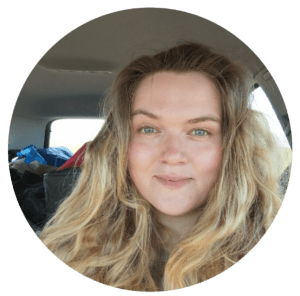
Article written by Rosie Corner.
In June 2022, with the generous support of the Alfred Toepfer Institute, I spent two weeks in Iceland researching my report into Sacred Natural Sites: areas of land or water having special spiritual significance to people and communities.
My trip took place in Þingvellir National Park, Vatnajokull National Park and Snæfellsjökull National Park as well as many more of Iceland’s 120+ protected areas.
I believe that sacred nature should matter to protected area managers because:
- More than three quarters of the world’s population consider themselves to hold some sort of religious belief. When people of faith visit protected areas they bring their belief systems with them, and this can impact how they perceive, experience and act towards the natural world. By building their religious literacy, protected area managers can engage better with people of faith and build towards better outcomes for nature.
- Protected area managers have the power to influence people’s beliefs about the value of the natural world. Regardless of whether or not a visitor to a protected area considers him/herself to be religious or spiritual, they have the ability to perceive nature as sacred: something which is too important to be changed. People who perceive their natural surroundings as sacred are more likely to take care of them.
The report you are about to read provides an introduction to the many ways in which a spiritual reading of the landscape and its non-human inhabitants can aid protected area management and enrich the visitor experience. The report is structured around Ninian Smart’s ‘dimensions of the sacred’: a framework which captures the broad and encompassing nature of religion. These are:
- Philosophical
- Ritual
- Narrative
- Experiential
- Ethical
- Social
- Material
In each section, I describe how these dimensions can be seen at play in protected areas and present an Icelandic case study to illustrate my ideas. The report ends with a manifesto of ten ways in which seeing nature as sacred can enrich protected areas.
Sacred nature in protected areas: A Manifesto
- Make the retail offer sustainable and meaningful. Every souvenir purchased from a protected area should become a treasured possession that encourages repeat visits and in depth engagement.
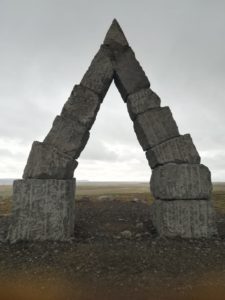
Artic Henge
- Organise and promote activities that cater for visitors of different faiths.
- Accept that engaging spiritually is one of the many different ways for visitors to experience a protected area. The more diverse the experiences that are available, the better the visitor offer.
- Make your code of conduct clear, attractive and connected to people’s spiritual value systems.
- Recognise that people are more likely to donate their time, energy and money to causes that resonate with them on a spiritual level.
- Provide places for people to experience complex emotions during challenging life stages.
- Acknowledge and promote the fact that protected areas are some of our greatest pieces of cultural heritage and markers of nationhood.
- View all protected area stakeholders as part of a congregation of owners, users and facilitators.
- Create opportunities for people of all faiths and none to celebrate important life events in inspirational surroundings.
- Under the Human Rights Act everyone has the right to freedom of thought, conscience and religion. When nature becomes sacred, access to it becomes a human right.
You can find all previous winners of the Alferd Toepfer Natural Heritage Scholarship here.
Welcome to our new Transboundary Area: The European Nature Park of Scarpe Escaut Plains!
Representatives of the Park Lisa Bardot and Raymond Zingraff receive the certification at the EUROPARC Conference 2022
At the Award Ceremony during the EUROPARC Conference 2022 in France, we were happy to welcome a new member to our Transboundary Parks Programme: The European Nature Park of Scarpe Escaut Plains. Get to know them in this article!
A territory shaped by the Scarpe and the Escaut rivers
The European Nature Park brings together the Scarpe-Escaut Regional Nature Park (PNRSE in France) and the Escaut Plains Nature Park (PNPE in Belgium). This territory has maintained a rural and natural character with many meadows, forests and wetlands, but is under pressure from the surrounding urban areas. At the intersection of major urban poles (Lille metropolis, Valencian, Douaisian and Tournaisian poles), its high population density, its industrial, mining, and natural heritage make it an atypical territory. It covers:
- On the French side: 55 municipalities representing a population of 190,000 inhabitants in the districts of Valenciennes and Douai.
- On the Walloon side: 7 communal entities (71 villages) for a population of 102,000 inhabitants in the districts of Ath and Tournai.
Visit the official website here.
Natural, cultural and landscape heritage
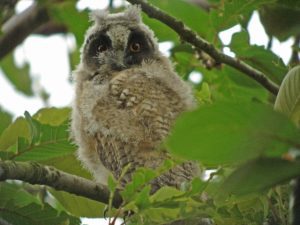
Owl at Scarpe Escaut
In terms of biodiversity, the lower valleys of the Scarpe and the Escaut rivers have wetlands of great ecological value. This includes marshes and alkaline peatlands, as well as natural or artificial ponds, which were, amongst others, created due to mining activities. Furthermore, the area has intensive or extensive wet meadows, alluvial forests and humid forests.
The hydrographic network is largely artificialized and restored. As such, it is dense and complex. These water-related environments are recognised as being of ecological interest at regional, national, European and international level (Ramsar site “Scarpe and Escaut Valley” in France and “Marais d’Harchies” in Wallonia).
There are 7500 ha of forests. Woods, poplar groves, alluvial forests and hedges. Rows of trees and orchards are sharing the space in the heart of the territory.
The European Nature Park also has a cultural heritage related to the history of abbeys on the territory (Ramsar labeling), as well as mining (UNESCO classification). This is one of the particularities of this territory, since it is a natural area that has always been inhabited, it constitutes a real «living landscape».
Long-standing cross-border cooperation
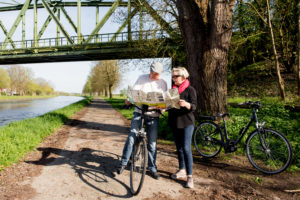
Bikepaths at Scarpe Escaut, Photo: Office du Tourisme de Bernissart
It was in 1983 that the cooperation between the two territories was formalized by the signing of a memorandum of understanding associating Wallonia and Nord-Pas de Calais for the creation of a “supra-border” nature park. It is thanks to various projects supported by the European Union in particular that the joint work between the two parks has been strengthened.
In 2010, as part of the renewal of the framework document of the Scarpe Escaut Regional Nature Park, the first cross-border charter (2010-2022) was signed and associated the Escaut Plaines Nature Park with the missions of the French Park.
Finally, it is in 2021 that the European Grouping of Territorial Cooperation of the European Nature Park of Scarpe Escaut Plains was created, which should make it possible to overcome the political, administrative and financial obstacles. Furthermore, it should act as an interface between local issues and decisions taken at a higher level.
Parks Rewarded
At the Award Ceremony, EUROPARC was also happy to honour the Parks that have renewed their commitment to the Transboundary Programme. These are the:
- Maas-Schwalm-Nette Nature Park on the border of Germany and the Netherlands;
- Saxon-Bohemian Switzerland between Germany and the Czech Republic;
- Neusiedler See – Seewinkel & Fertö-Hansag National Parks in Austria and Romania.
It brings us great join to see our Transboundary Programme continuously growing. Welcome to all candidates, new and old!